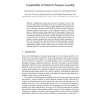Free Online Productivity Tools
i2Speak
i2Symbol
i2OCR
iTex2Img
iWeb2Print
iWeb2Shot
i2Type
iPdf2Split
iPdf2Merge
i2Bopomofo
i2Arabic
i2Style
i2Image
i2PDF
iLatex2Rtf
Sci2ools
WABI
2007
Springer
2007
Springer
Computability of Models for Sequence Assembly
Graph-theoretic models have come to the forefront as some of the most powerful and practical methods for sequence assembly. Simultaneously, the computational hardness of the underlying graph algorithms has remained open. Here we present two theoretical results about the complexity of these models for sequence assembly. In the first part, we show sequence assembly to be NP-hard under two different models: string graphs and de Bruijn graphs. Together with an earlier result on the NP-hardness of overlap graphs, this demonstrates that all of the popular graph-theoretic sequence assembly paradigms are NP-hard. In our second result, we give the first, to our knowledge, optimal polynomial time algorithm for genome assembly that explicitly models the double-strandedness of DNA. We solve the Chinese Postman Problem on bidirected graphs using bidirected flow techniques and show to how to use it to find the shortest doublestranded DNA sequence which contains a given set of ¦ -long words. Thi...
Algorithms | Graph-theoretic Models | Graph-theoretic Sequence Assembly | Sequence Assembly | WABI 2007 |
| Added | 09 Jun 2010 |
| Updated | 09 Jun 2010 |
| Type | Conference |
| Year | 2007 |
| Where | WABI |
| Authors | Paul Medvedev, Konstantinos Georgiou, Gene Myers, Michael Brudno |
Comments (0)

